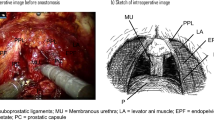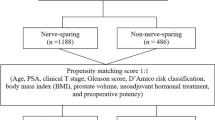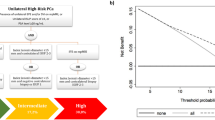Abstract
There are essentially two ways to accomplish nerve preservation during radical retropubic prostatectomy: the ‘apical approach’ described by Walsh and the so-called ‘lateral approach’, a simplified method where the dissection is initially conducted on the portion of the bundles that courses posterolateral to the prostate. Do the different techniques differ in the ability to preserve potency and in the positive surgical margins rate? No previous study has addressed this question. Above all, the preoperative and intraoperative indications to spare or not the nerves remain a matter of debate. The present review is an attempt to elucidate these questions in light of the current literature.
This is a preview of subscription content, access via your institution
Access options
Subscribe to this journal
Receive 4 print issues and online access
$259.00 per year
only $64.75 per issue
Buy this article
- Purchase on Springer Link
- Instant access to full article PDF
Prices may be subject to local taxes which are calculated during checkout
Similar content being viewed by others
References
Schlegel PN, Walsh PC . Neuroanatomical approach to radical cystoprostatectomy with preservation of sexual function. J Urol 1987; 138: 1402–1406.
Walsh PC, Donker PJ . Impotence following radical prostatectomy: insight into etiology and prevention. J Urol 1982; 128: 492–497.
Lue TF, Zeineh SJ, Schmidt RA, Tanagho EA . Neuroanatomy of penile erection: its relevance to iatrogenic impotence. J Urol 1984; 131: 273–280.
Lepor H et al. Precise localization of the autonomic nerves from the pelvic plexus to the corpora cavernosa: a detailed anatomical study of the adult male pelvis. J Urol 1985; 133: 207–212.
Gillitzer R, Thuroff JW . Technical advances in radical retropubic prostatectomy techniques for avoiding complications. Part II: vesico-urethral anastomosis and nerve-sparing prostatectomy. BJU Int 2003; 92: 178–184.
Walsh PC . Anatomic radical prostatectomy: evolution of the surgical technique. J Urol 1998; 160 (6, Part 2): 2418–2424.
Walsh PC . Anatomic radical retropubic prostatectomy. In: Walsh PC, Retik AB, Vaughan Jr ED, Wein AJ (eds). Campbell's Urology, Vol 4, Chapter 90, 8th edn. WB Saunders Co.: Philadelphia, PA, 2002, pp 3107–3129.
Ruckle HC, Zincke H . Potency-sparing radical retropubic prostatectomy: a simplified anatomical approach. J Urol 1995; 153: 1875–1877.
Klein EA, Kupelian PA, Tuason L, Levin HS . Initial dissection of the lateral fascia reduces the positive margin rate in radical prostatectomy. Urology 1998; 51: 766–773.
Jarow JP, Trock BJ . Anatomic radical prostatectomy: does initial dissection of lateral fascia affects outcomes? J Urol 2002; 167 (Suppl): A1363.
Fernandez S et al. Experience with water-jet dissection in nerve sparing radical prostatectomy. J Urol 2002; 167 (Suppl): A1338.
Goldwasser B, Zincke H . Modified Deschamps needle for securing dorsal vein complex and urethra during radical retropubic prostatectomy. Urology 1989; 33: 324–328.
Goad JR, Scardino PT . Modifications in the technique of radical prostatectomy to minimize blood loss. Atlas Urol Clin North Am 1994; 2: 65–80.
Ohori N, Scardino PT . Localized prostate cancer. Curr Prob Surg 2002; 39: 833–960.
Stephenson RA, Middleton RG, Abbott TM . Wide excision (nonnerve sparing) radical retropubic prostatectomy using an initial perirectal dissection. J Urol 1997; 157: 251–255.
Han M et al. Long-term biochemical disease-free and cancer-specific survival following anatomic radical retropubic prostatectomy. The 15-year Johns Hopkins experience. Urol Clin North Am 2001; 28: 555–565.
Grossfeld GD et al. Under staging and under grading in a contemporary series of patients undergoing radical prostatectomy: results from the Cancer of the Prostate Strategic Urologic Research Endeavor database. J Urol 2001; 165: 851–856.
Kausik SJ et al. Prognostic significance of positive surgical margins in patients with extraprostatic carcinoma after radical prostatectomy. Cancer 2002; 95: 1215–1219.
Epstein JI . Pathologic assessment of the surgical specimen. Urol Clin North Am 2001; 28: 567–594.
Wieder JA, Soloway MS . Incidence, etiology, location, prevention and treatment of positive surgical margins after radical prostatectomy for prostate cancer. J Urol 1998; 160: 299–315.
Ohory M et al. Prognostic significance of positive surgical margins in radical prostatectomy specimens. J Urol 1992; 148: 331.
Walsh PC . Radical prostatectomy for localised prostate cancer provides durable cancer control with excellent quality of life: a structured debate. J Urol 2000; 163: 1802–1807.
Catalona WJ, Basler JW . Return of erections and urinary continence following nerve sparing radical retropubic prostatectomy. J Urol 1993; 150: 905–909.
Standford JL et al. Urinary and sexual function after radical prostatectomy for clinically localised prostate cancer: the prostate cancer outcomes study. JAMA 2000; 283: 354–360.
Talcott JA et al. Patient-reported impotence and incontinence after nerve-sparing radical prostatectomy. J Natl Cancer Inst 1997; 89: 1117–1123.
Rabbani F et al. Factors predicting recovery of erections after radical prostatectomy. J Urol 2000; 164: 1929–1934.
Walsh PC et al. Patient-reported urinary continence and sexual function after anatomic radical prostatectomy. Urology 2000; 55: 58–61.
Noh C, Kshirsagar A, Mohler JL . Outcomes after radical retropubic prostatectomy. Urology 2003; 61: 412–416.
McCullough AR . Prevention and management of erectile dysfunction following radical prostatectomy. Urol Clin North Am 2001; 28: 613–627.
Walsh PC, Marschke P, Ricker D, Burnett AL . Use of intraoperative video documentation to improve sexual function after radical retropubic prostatectomy. Urology 2000; 55: 62–67.
Padma-Nathan H et al. Postoperative nightly administration of sildenafil citrate significantly improves the return of normal spontaneous erectile function after bilateral nerve-sparing radical prostatectomy. J Urol 2003; 169 (Suppl): 1402.
Montorsi F, Burnett AL . Erectile dysfunction after radical prostatectomy. BJU Int 2004; 93: 1–2.
Montorsi F et al. Current and future strategies for preventing and managing erectile dysfunction following radical prostatectomy. Eur Urol 2004; 45: 123–133.
Van der Aa F, Joniau S, De Ridder D, Van Poppel H . Potency after unilateral nerve sparing surgery: a report on functional and oncological results of unilateral nerve sparing surgery. Prostate Cancer P D 2003; 6: 61–65.
Schnall MD et al. Prostate cancer: local staging with endorectal surface coil MR imaging. Radiology 1991; 178: 797–802.
Geary ES, Stamey TA . Pathological characteristics and prognosis of nonpalpable and palpable prostate cancers with a Hybritech prostate specific antigen of 4 to 10?ng/ml. J Urol 1996; 156: 1056–1058.
Daniels Jr GF, McNeal JE, Stamey TA . Predictive value of controlateral biopsies in unilaterally palpable prostate cancer. J Urol 1992; 147: 870–874.
Catalona WJ . Patient selection for, results of, and impact on tumor resection of potency-sparing radical prostatectomy. Urol Clin North Am 1990; 17: 819–822.
Ackerman DA et al. Analysis of risk factors associated with prostate cancer extension to the surgical margin and pelvic node metastasis at radical prostatectomy. J Urol 1993; 150: 1845–1850.
Scaletscky R et al. Tumor volume and stage in carcinoma of the prostate detected by elevations in prostate specific antigen. J Urol 1994; 152: 129–131.
Partin AW et al. Combination of prostate-specific antigen, clinical stage, and Gleason score to predict pathological stage of localized prostate cancer. A multi-institutional update. JAMA 1997; 277: 1445–1451.
Cheng L et al. Preoperative prediction of surgical margin status in patients with prostate cancer treated by radical prostatectomy. J Clin Oncol 2000; 18: 2862–2868.
Tigrani VS, Bhargava V, Shinohara K, Presti Jr JC . Number of positive systematic sextant biopsies predicts surgical margin status at radical prostatectomy. Urology 1999; 54: 689–693.
Alsikafi NF, Brendler CB . Surgical modifications of radical retropubic prostatectomy to decrease incidence of positive surgical margins. J Urol 1998; 159: 1281–1285.
Park E, Dalkin B, Escobar C, Nagle RB . Site-specific positive margins at radical prostatectomy: assessing cancer-control benefits of wide excision of the neurovascualr bundle on a side with cancer on biopsy. BJU Int 2003; 91: 219–222.
Sanwick JM, Dalkin BL, Nagle RB . Accuracy of prostate needle biopsy in predicting extracapsular tumor extension at radical retropubic prostatectomy: application in selecting patients for nerve-sparing surgery. Urology 1998; 52: 814–818.
Graefen M et al. A validated strategy for side specific prediction of organ confined prostate cancer: a tool to select for nerve sparing radical prostatectomy. J Urol 2001; 165: 857–863.
Huland H, Hubner D, Henke RP . Systematic biopsies and digital rectal examination to identify the nerve-sparing side for radical prostatectomy without risk of positive margin in patients with clinical stage T2, N0 prostatic carcinoma. Urology 1994; 44: 211–214.
Walsh PC . Letter to editor. J Urol 2001; 165: 915.
Holmes GF, Walsh PC, Pound CR, Epstein JI . Excision of the neurovascular bundle at radical prostatectomy in cases with perineural invasion on needle biopsy. Urology 1999; 53: 752–756.
Scardino PT, Kim ED . Rationale for and results of nerve grafting during radical prostatectomy. Urology 2001; 57: 301–307.
Obek C et al. Positive surgical margins with radical retropubic prostatectomy: anatomic site-specific pathologic analysis and impact on prognosis. Urology 1999; 54: 682–688.
Shah O, Melamed J, Lepor H . Analysis of apical soft tissue margins during radical retropubic prostatectomy. J Urol 2001; 165 (6, Part 1 of 2): 1943–1949.
Goharderakhshan RZ et al. Utility of intraoperative frozen section analysis of surgical margins in region of neurovascular bundles at radical prostatectomy. Urology 2002; 59: 709–714.
May F et al. Limited value of endorectal magnetic resonance imaging and transrectal ultrasonography in the staging of clinically localized prostate cancer. BJU Int 2001; 87: 66–69.
Epstein JI . Evaluation of radical prostatectomy capsular margins of resection. The significance of margins designated as negative, closely approaching, and positive. Am J Surg Pathol 1990; 14: 626–632.
Cangiano TG et al. Intraoperative frozen section monitoring of nerve sparing radical retropubic prostatectomy. J Urol 1999; 162 (3, Part 1): 655–658.
Sofer M, Hamilton-Nelson KL, Schlesselman JJ, Soloway MS . Risk of positive margins and biochemical recurrence in relation to nerve-sparing radical prostatectomy. J Clin Oncol 2002; 20: 1853–1858.
Walsh PC . Nerve grafts are rarely necessary and are unlikely to improve sexual function in men undergoing anatomic radical prostatectomy. Urology 2001; 57: 1020–1024.
Shah O, Robbins DA, Melamed J, Lepor H . The New York University nerve sparing algorithm decreases the rate of positive surgical margins following radical retropubic prostatectomy. J Urol 2003; 169: 2147–2152.
McNeal JE et al. Capsular penetration in prostate cancer. Significance for natural history and treatment. Am J Surg Pathol 1990; 14: 240–247.
Catalona WJ, Bigg SW . Nerve-sparing radical prostatectomy: evaluation of results after 250 patients. J Urol 1990; 143: 538–543.
Epstein JI, Partin AW, Sauvageot J, Walsh PC . Prediction of progression following radical prostatectomy. A multivariate analysis of 721 men with long-term follow-up. Am J Surg Pathol 1996; 20: 286–291.
Eastham JA et al. Variations among individual surgeons in the rate of positive surgical margins in radical prostatectomy specimens. J Urol 2003; 170 (6, Part 1): 2292–2295.
Rosen MA et al. Frequency and location of extracapsular extension and positive surgical margins in radical prostatectomy specimens. J Urol 1992; 148 (2, Part 1): 331–337.
Ohori M et al. Prognostic significance of positive surgical margins in radical prostatectomy specimens. J Urol 1995; 154: 1818–1824.
Wahle S et al. Incidence of surgical margin involvement in various forms of radical prostatectomy. Urology 1990; 36: 23–26.
Jones EC . Resection margin status in radical retropubic prostatectomy specimens: relationship to type of operation, tumor size, tumor grade and local tumor extension. J Urol 1990; 144: 89–93.
van den Ouden D, Bentvelsen FM, Boeve ER, Schroder FH . Positive margins after radical prostatectomy: correlation with local recurrence and distant progression. Br J Urol 1993; 72: 489–494.
Eggleston JC, Walsh PC . Radical prostatectomy with preservation of sexual function: pathological findings in the first 100 cases. J Urol 1985; 134: 1146–1148.
Epstein JI, Pizov G, Walsh PC . Correlation of pathologic findings with progression after radical retropubic prostatectomy. Cancer 1993; 71: 3582–3593.
Misop H, Partin AW, Chan DY, Walsh PC . An evaluation of the decreasing incidence of positive surgical margins in a large retropubic prostatectomy series. J Urol 2004; 171: 23–26.
Smith RC, Partin AW, Epstein JI, Brendler CB . Extended followup of the influence of wide excision of the neurovascular bundle(s) on prognosis in men with clinically localized prostate cancer and extensive capsular perforation. J Urol 1996; 156: 454–457.
Soulie M et al. Impact of a modified apical dissection during radical retropubic prostatectomy on the occurrence of positive surgical margins: a comparative study in 212 patients. Urology 2001; 58: 217–221.
Stamey TA et al. Positive surgical margins at radical prostatectomy: importance of the apical dissection. J Urol 1990; 143: 1166–1172.
Barocas DA et al. Does capsular incision at radical retropubic prostatectomy affect disease-free survival in otherwise organ-confined prostate cancer? Urology 2001; 58: 746–751.
Blute ML et al. Pathologic classification of prostate carcinoma: the impact of margin status. Cancer 1998; 82: 902–908.
Salomon L et al. Location of positive surgical margins after retropubic, perineal, and laparoscopic radical prostatectomy for organ-confined prostate cancer. Urology 2003; 61: 386–390.
Katz R et al. Positive surgical margins in laparoscopic radical prostatectomy: the impact of apical dissection, bladder neck remodeling and nerve preservation. J Urol 2003; 169: 2049–2052.
Roumeguere T et al. Radical prostatectomy: a prospective comparison of oncological and functional results between open and laparoscopic approaches. World J Urol 2003; 20: 360–366.
Author information
Authors and Affiliations
Corresponding author
Rights and permissions
About this article
Cite this article
Gontero, P., Kirby, R. Nerve-sparing radical retropubic prostatectomy: techniques and clinical considerations. Prostate Cancer Prostatic Dis 8, 133–139 (2005). https://doi.org/10.1038/sj.pcan.4500781
Received:
Revised:
Accepted:
Published:
Issue Date:
DOI: https://doi.org/10.1038/sj.pcan.4500781
Keywords
This article is cited by
-
3D printed patient-specific prostate cancer models to guide nerve-sparing robot-assisted radical prostatectomy: a systematic review
Journal of Robotic Surgery (2022)
-
Risks and complications of robot-assisted radical prostatectomy (RARP) in patients receiving antiplatelet and/or anticoagulant therapy: a retrospective cohort study in a single institute
Journal of Robotic Surgery (2021)
-
Impact of multiparametric MRI and MRI-targeted biopsy on pre-therapeutic risk assessment in prostate cancer patients candidate for radical prostatectomy
World Journal of Urology (2019)
-
Clinical impact of intraoperative frozen sections during nerve-sparing radical prostatectomy
World Journal of Urology (2010)
-
The psychosocial aspects of sexual recovery after prostate cancer treatment
International Journal of Impotence Research (2009)



